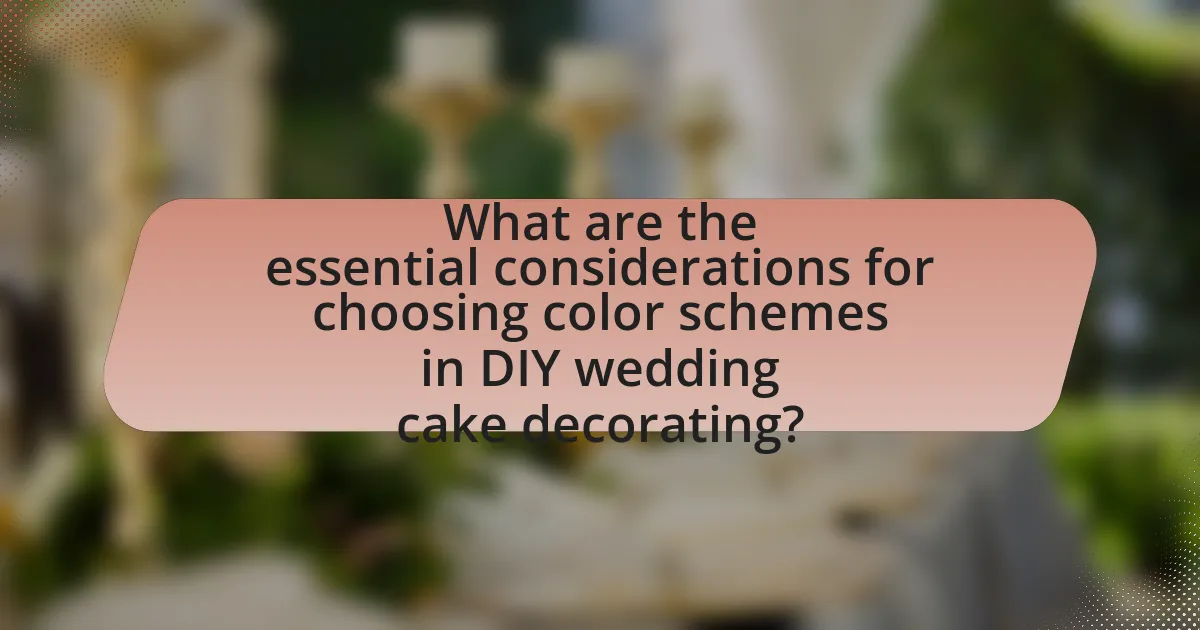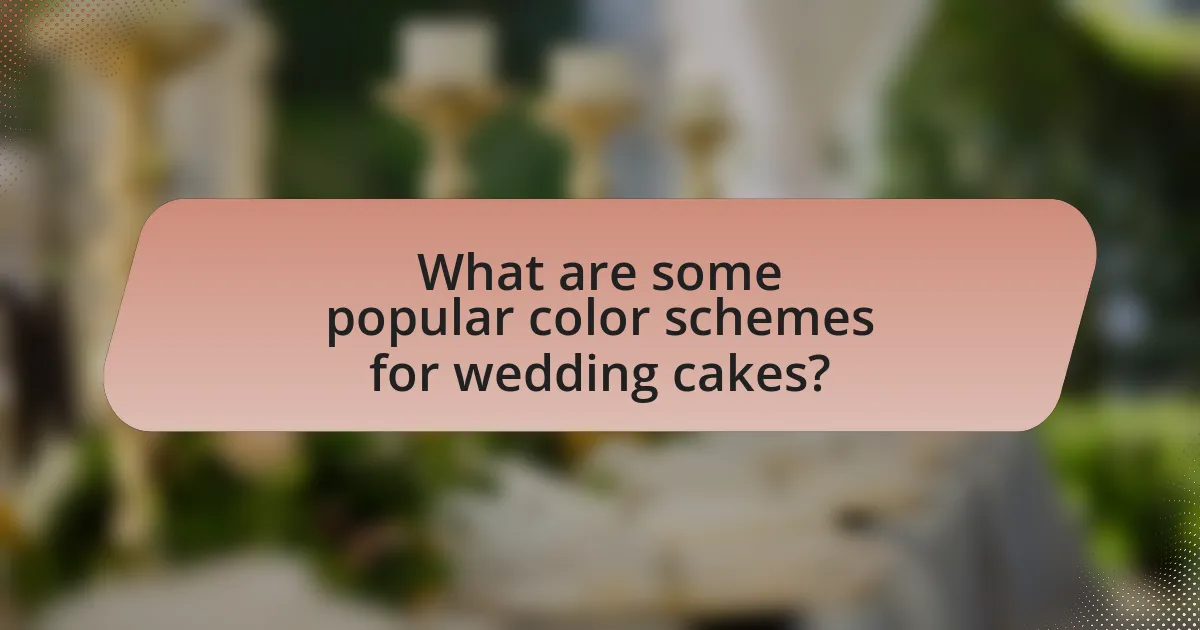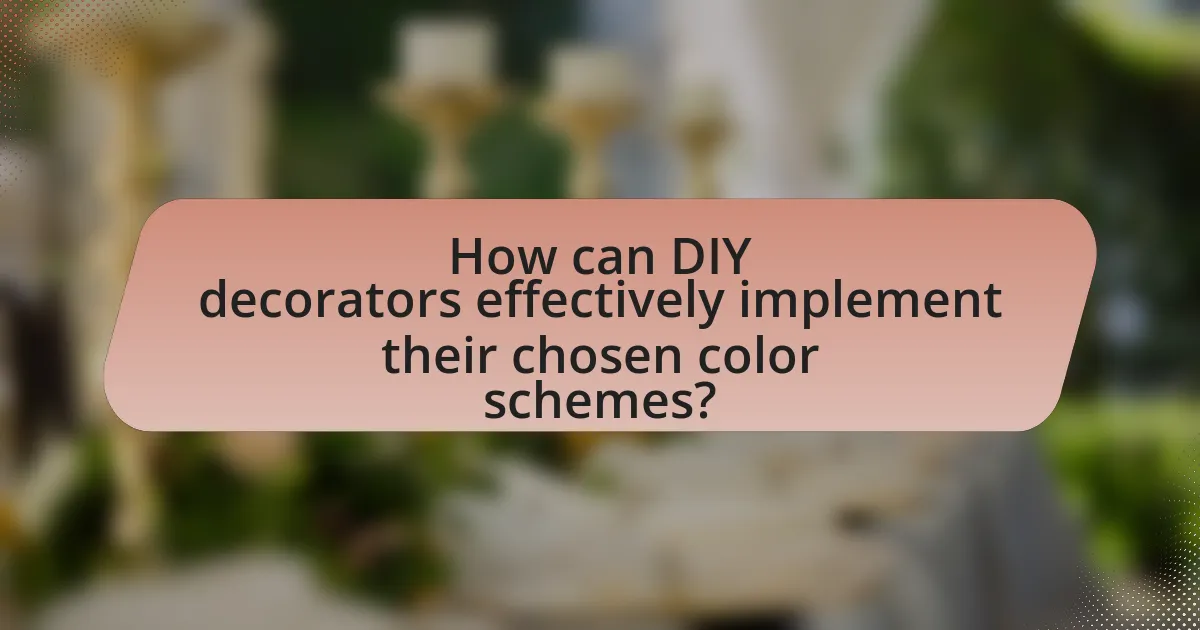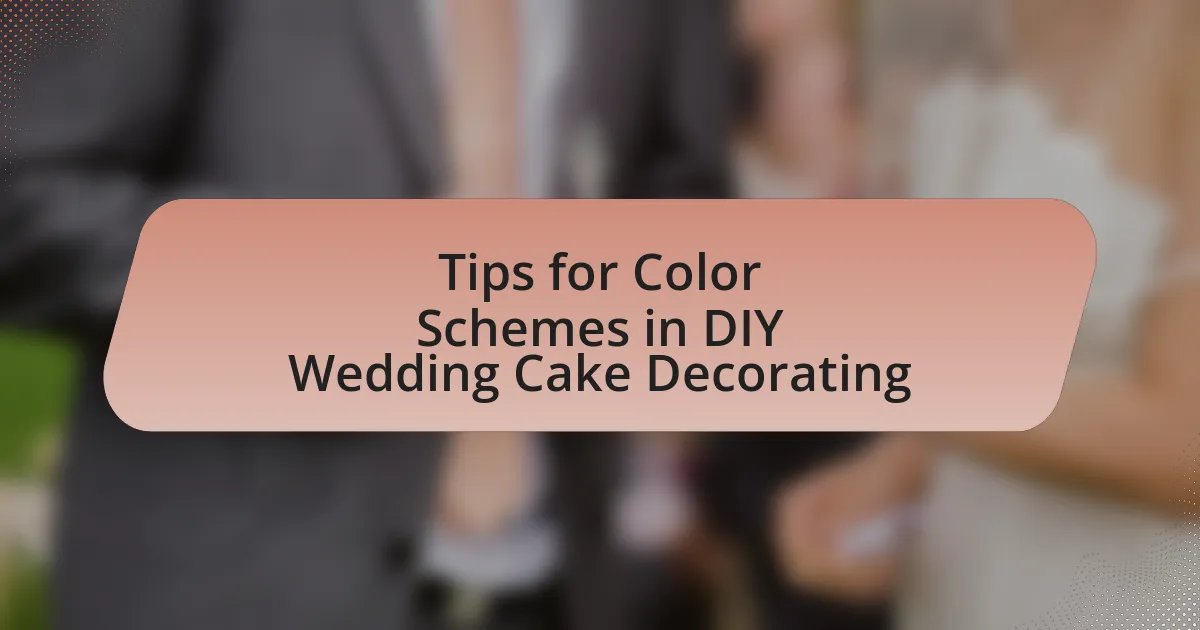The article focuses on essential tips for selecting color schemes in DIY wedding cake decorating, emphasizing the importance of aligning colors with the wedding theme, color psychology, and seasonal trends. It discusses how color choices influence the overall aesthetic and emotional tone of the cake, highlighting popular color combinations and the principles of color theory relevant to cake design. Additionally, the article provides practical advice on blending colors, avoiding common mistakes, and utilizing tools for effective color selection, ensuring decorators can create visually appealing and cohesive designs that enhance the wedding celebration.

What are the essential considerations for choosing color schemes in DIY wedding cake decorating?
The essential considerations for choosing color schemes in DIY wedding cake decorating include the wedding theme, color psychology, and seasonal colors. The wedding theme dictates the overall aesthetic, ensuring that the cake complements the venue and decor. Color psychology plays a crucial role, as different colors evoke specific emotions; for example, soft pastels convey romance, while bold colors can signify celebration. Additionally, seasonal colors can enhance the cake’s appeal, aligning it with the time of year, such as warm tones for autumn or cool hues for winter. These factors collectively guide the selection of a cohesive and visually appealing color scheme for the wedding cake.
How do color schemes influence the overall aesthetic of a wedding cake?
Color schemes significantly influence the overall aesthetic of a wedding cake by establishing the visual theme and emotional tone of the event. A well-chosen color palette can enhance the cake’s design, making it a focal point that complements the wedding’s decor and style. For instance, soft pastels evoke a romantic and delicate atmosphere, while bold colors can create a modern and vibrant look. Research indicates that color psychology plays a crucial role in how people perceive aesthetics; for example, blue is often associated with calmness, while red can signify passion. Therefore, selecting a cohesive color scheme not only enhances the cake’s appearance but also aligns it with the couple’s vision and the overall ambiance of the wedding.
What emotions do different colors evoke in wedding cake design?
Different colors in wedding cake design evoke specific emotions that can enhance the overall atmosphere of the celebration. For instance, white symbolizes purity and innocence, often associated with traditional weddings. Pink conveys romance and sweetness, making it a popular choice for a soft, loving ambiance. Blue represents tranquility and calmness, which can create a serene environment. Red evokes passion and love, adding a bold statement to the cake design. Yellow signifies happiness and cheerfulness, contributing to a joyful celebration. Green symbolizes growth and harmony, often used to reflect nature and freshness. Each color choice can significantly influence the emotional tone of the wedding, aligning with the couple’s vision and theme.
How can color schemes reflect the wedding theme or season?
Color schemes can effectively reflect the wedding theme or season by aligning colors with specific motifs and seasonal palettes. For instance, a rustic wedding theme may incorporate earthy tones like browns and greens, while a summer wedding often features bright, vibrant colors such as yellows and pinks. Seasonal color trends are supported by color theory, which indicates that certain colors evoke specific emotions and associations; for example, pastels are commonly associated with spring, symbolizing renewal and freshness. This alignment enhances the overall aesthetic and coherence of the wedding, making the color scheme a crucial element in cake decorating that resonates with the chosen theme and season.
What are the basic principles of color theory relevant to cake decorating?
The basic principles of color theory relevant to cake decorating include the color wheel, color harmony, and the psychological effects of colors. The color wheel illustrates primary, secondary, and tertiary colors, which help decorators understand how to mix and match colors effectively. Color harmony involves creating visually appealing combinations, such as complementary, analogous, or triadic schemes, which enhance the overall aesthetic of the cake. Additionally, the psychological effects of colors influence emotions and perceptions; for example, blue can evoke calmness, while red may stimulate excitement. Understanding these principles allows cake decorators to create visually stunning and emotionally resonant designs.
What are the primary, secondary, and tertiary colors?
Primary colors are red, blue, and yellow. These colors cannot be created by mixing other colors. Secondary colors, which are formed by mixing two primary colors, include green (blue and yellow), orange (red and yellow), and purple (red and blue). Tertiary colors result from mixing a primary color with a secondary color, leading to hues such as red-orange, yellow-orange, yellow-green, blue-green, blue-purple, and red-purple. This classification is based on the color wheel, a tool widely used in art and design to understand color relationships.
How do complementary and analogous colors work in cake design?
Complementary colors in cake design are pairs of colors that are opposite each other on the color wheel, such as blue and orange, which create a vibrant contrast that can make cake decorations stand out. This contrast draws attention and can highlight specific elements of the cake, enhancing visual appeal. Analogous colors, on the other hand, are colors that are next to each other on the color wheel, like blue, blue-green, and green, which create a harmonious and cohesive look. Using analogous colors in cake design can evoke a sense of tranquility and elegance, making the cake visually pleasing without overwhelming the viewer. Both color schemes can be effectively utilized in DIY wedding cake decorating to achieve desired aesthetic effects, with complementary colors providing boldness and analogous colors offering subtlety.
What tools and resources can help in selecting color schemes for wedding cakes?
Color palette generators and color theory resources are essential tools for selecting color schemes for wedding cakes. Online platforms like Adobe Color and Coolors allow users to create and visualize color combinations, ensuring that the chosen colors complement each other effectively. Additionally, color wheel tools help in understanding color relationships, such as complementary and analogous colors, which are crucial for aesthetic appeal. Resources like wedding planning websites and Pinterest provide inspiration through curated images of wedding cakes, showcasing trending color schemes and styles. These tools and resources collectively aid in making informed decisions about color selection for wedding cakes, enhancing their visual impact.
What color palette generators are available for DIY decorators?
Color palette generators available for DIY decorators include Coolors, Adobe Color, and Paletton. Coolors allows users to create, save, and share color schemes quickly, making it ideal for decorators seeking inspiration. Adobe Color offers advanced features such as color harmony rules and the ability to extract color palettes from images, which is beneficial for matching wedding themes. Paletton provides a user-friendly interface for generating color combinations based on a selected base color, helping decorators visualize their designs effectively. These tools are widely recognized in the design community for their functionality and ease of use.
How can inspiration from nature or wedding decor assist in color selection?
Inspiration from nature or wedding decor can significantly assist in color selection by providing a harmonious palette that reflects the event’s theme and ambiance. Nature offers a variety of color combinations found in flowers, landscapes, and seasonal changes, which can guide the choice of colors that evoke specific emotions or settings. For example, a spring wedding may draw from pastel colors seen in blooming flowers, while a fall wedding might utilize warm earth tones inspired by autumn leaves. Additionally, wedding decor often features coordinated color schemes that enhance the overall aesthetic, such as table settings, floral arrangements, and linens, which can serve as a reference for selecting complementary colors for the cake. This approach ensures that the cake aligns visually with the wedding’s overall design, creating a cohesive look.

What are some popular color schemes for wedding cakes?
Popular color schemes for wedding cakes include classic white and cream, soft pastels like blush and mint, bold jewel tones such as emerald and sapphire, and elegant metallics like gold and silver. These color combinations are favored for their ability to complement various wedding themes and settings. For instance, the classic white and cream scheme is timeless and versatile, often associated with traditional weddings, while soft pastels are popular for spring and summer celebrations. Bold jewel tones add a rich, luxurious feel, suitable for fall or winter weddings, and metallics provide a modern touch that enhances sophistication.
What are the trending color combinations for wedding cakes this year?
The trending color combinations for wedding cakes this year include soft pastels like blush pink and mint green, as well as bold contrasts such as navy blue and gold. These combinations reflect current wedding trends that emphasize elegance and personalization. According to wedding industry reports, pastel shades have gained popularity for their romantic appeal, while navy and gold provide a sophisticated touch, making them ideal for formal celebrations.
How do pastels create a romantic feel in wedding cake designs?
Pastels create a romantic feel in wedding cake designs by evoking softness and delicacy through their muted tones. These colors, such as blush pink, lavender, and mint green, are often associated with love and tranquility, enhancing the overall aesthetic of a wedding. The gentle hues of pastels can complement floral arrangements and other decor, creating a cohesive and serene atmosphere. Studies in color psychology indicate that soft colors can elicit feelings of calmness and affection, further reinforcing the romantic ambiance desired in wedding celebrations.
What role do metallics play in modern wedding cake aesthetics?
Metallics play a significant role in modern wedding cake aesthetics by adding elegance and sophistication to the overall design. The incorporation of metallic elements, such as gold, silver, and copper, enhances visual appeal and creates a luxurious feel, which aligns with contemporary wedding themes. According to a survey by The Knot, 30% of couples in 2022 opted for metallic accents in their wedding decor, indicating a strong trend towards this aesthetic. This trend is further supported by the use of metallic edible paints and foils, which allow cake decorators to achieve intricate designs and textures that elevate the cake’s appearance.
How can seasonal colors enhance the wedding cake’s appeal?
Seasonal colors can significantly enhance a wedding cake’s appeal by creating a visual connection to the time of year, making the cake more relevant and memorable for the occasion. For example, pastel colors in spring evoke freshness and renewal, while rich, warm tones in autumn reflect the season’s harvest. This alignment with seasonal themes not only elevates the aesthetic but also resonates emotionally with guests, reinforcing the overall wedding atmosphere. Studies in color psychology indicate that colors can influence perceptions and feelings, suggesting that a well-chosen seasonal palette can enhance enjoyment and satisfaction during the celebration.
What colors are typically associated with spring weddings?
Colors typically associated with spring weddings include pastels such as blush pink, lavender, mint green, and soft yellow. These colors reflect the blooming flowers and fresh greenery of the season, creating a romantic and vibrant atmosphere. The use of pastel shades is supported by wedding industry trends, which indicate that lighter hues are favored for spring ceremonies, aligning with nature’s palette during this time.
How do autumn hues influence cake decoration choices?
Autumn hues significantly influence cake decoration choices by guiding color palettes that evoke the season’s warmth and richness. These colors, such as deep oranges, burgundies, and golden yellows, create a cozy and inviting atmosphere, making them popular for fall-themed weddings. The use of these shades can enhance the overall aesthetic of the cake, aligning it with seasonal themes and floral arrangements commonly found in autumn weddings. For instance, a study by the Color Marketing Group indicates that warm colors are associated with comfort and nostalgia, which can enhance the emotional appeal of wedding cakes during this season.
What are some classic color schemes that never go out of style?
Classic color schemes that never go out of style include combinations such as black and white, navy and gold, and blush pink with ivory. These color pairings have been widely used in various design contexts, including wedding cake decorating, due to their timeless appeal and versatility. For instance, black and white creates a sophisticated and elegant look, while navy and gold adds a touch of luxury. Blush pink and ivory evoke a soft, romantic atmosphere, making them popular choices for weddings. These schemes have consistently appeared in design trends over the years, reinforcing their status as enduring favorites.
How does a black and white color scheme create elegance in cake design?
A black and white color scheme creates elegance in cake design by providing a timeless and sophisticated contrast that enhances visual appeal. This stark combination allows for intricate details and textures to stand out, making elements like lace, fondant, and piping more pronounced. The use of black and white in cake design has historical significance, often associated with formal occasions and high-end aesthetics, which reinforces its elegant perception. Additionally, studies in color psychology indicate that black conveys sophistication and authority, while white symbolizes purity and simplicity, together creating a balanced and refined look that is highly desirable in wedding cake decorating.
What makes a red and gold combination timeless for weddings?
The red and gold combination is timeless for weddings due to its rich symbolism and aesthetic appeal. Red represents love, passion, and commitment, while gold signifies luxury, prosperity, and elegance. This pairing creates a striking visual contrast that enhances the overall decor, making it suitable for various wedding themes, from traditional to modern. Historically, red and gold have been favored in many cultures for celebrations, reinforcing their enduring popularity in wedding ceremonies.

How can DIY decorators effectively implement their chosen color schemes?
DIY decorators can effectively implement their chosen color schemes by selecting a cohesive palette that aligns with their overall theme and utilizing color theory principles. For instance, decorators should choose a primary color and complement it with two to three accent colors to create visual interest and harmony. Research indicates that color combinations can influence emotions and perceptions; for example, blue and white evoke calmness, while vibrant colors like red and yellow can stimulate excitement. By applying these principles, decorators can ensure that their color choices enhance the aesthetic appeal of the wedding cake, making it a focal point of the celebration.
What techniques can be used to blend colors seamlessly in cake decorating?
Techniques to blend colors seamlessly in cake decorating include the use of airbrushing, ombre effects, and color marbling. Airbrushing allows for a smooth gradient by layering colors, creating a soft transition that is visually appealing. The ombre technique involves gradually changing the color from light to dark, which can be achieved by mixing different shades of the same color. Color marbling combines two or more colors to create a swirled effect, often using a spatula or a skewer to achieve the desired pattern. These methods are widely used by cake decorators to enhance the aesthetic appeal of cakes, ensuring a professional finish.
How can ombre effects enhance the visual appeal of a wedding cake?
Ombre effects can significantly enhance the visual appeal of a wedding cake by creating a gradient of colors that adds depth and dimension. This technique allows for a smooth transition between shades, making the cake visually striking and modern. Research indicates that color gradients can evoke emotional responses, with softer hues often associated with romance and elegance, which aligns well with wedding themes. Additionally, ombre designs can be customized to match the wedding color palette, ensuring cohesion with other decor elements. This adaptability and aesthetic impact make ombre effects a popular choice in contemporary wedding cake design.
What are the best practices for using fondant and buttercream in color application?
The best practices for using fondant and buttercream in color application include using gel food colors for vibrant hues, mixing colors thoroughly to achieve uniformity, and applying colors gradually to control intensity. Gel food colors are preferred because they provide rich pigmentation without altering the consistency of the fondant or buttercream. Thorough mixing ensures that the color is evenly distributed, preventing streaks or uneven patches. Gradual application allows for better control over the final shade, enabling decorators to achieve the desired color without oversaturating the medium. These practices are supported by industry standards in cake decorating, which emphasize the importance of color consistency and vibrancy in professional cake design.
What common mistakes should be avoided when selecting and applying color schemes?
Common mistakes to avoid when selecting and applying color schemes include using too many colors, which can create visual chaos, and failing to consider the cake’s overall theme and setting, leading to a mismatch. Additionally, neglecting color harmony can result in clashing shades that detract from the cake’s appeal. Research indicates that color theory principles, such as complementary and analogous colors, enhance aesthetic appeal when applied correctly. Therefore, adhering to a limited palette and ensuring color coordination with the wedding theme are essential for a cohesive design.
How can over-saturation of colors detract from the cake’s design?
Over-saturation of colors can detract from a cake’s design by overwhelming the visual appeal and creating a chaotic appearance. When colors are excessively bright or numerous, they can clash and distract from the cake’s intended aesthetic, making it difficult for the viewer to appreciate the overall design. Research in color theory indicates that harmonious color combinations enhance visual appeal, while over-saturation can lead to visual fatigue, reducing the cake’s attractiveness. Therefore, a balanced color palette is essential for effective cake design.
What are the pitfalls of mismatched colors in wedding cake decorating?
Mismatched colors in wedding cake decorating can lead to a visually unappealing cake that detracts from the overall aesthetic of the wedding. When colors clash, it can create a disjointed look that fails to harmonize with the wedding theme, making the cake appear out of place. Additionally, mismatched colors can confuse guests about the flavor or type of cake, as certain colors may be associated with specific flavors or fillings. Research indicates that color psychology plays a significant role in food perception; for instance, a study published in the journal “Food Quality and Preference” found that color influences taste expectations. Therefore, ensuring a cohesive color scheme is essential for both visual appeal and guest experience.
What practical tips can help ensure a successful color scheme in DIY wedding cake decorating?
To ensure a successful color scheme in DIY wedding cake decorating, select a cohesive palette that complements the wedding theme. Start by choosing two to three main colors that harmonize well together, considering the venue and floral arrangements. Utilize color theory principles, such as complementary or analogous colors, to create visual interest. For instance, pairing soft pastels with a bold accent can enhance the overall aesthetic. Additionally, test color combinations on a small scale before applying them to the cake, as colors may appear differently when mixed with frosting or fondant. This approach helps avoid unexpected results and ensures the final design aligns with the desired vision.
How can decorators test color combinations before finalizing their designs?
Decorators can test color combinations before finalizing their designs by using color swatches and digital design tools. Color swatches allow decorators to physically see how colors interact in various lighting conditions, while digital design tools enable them to visualize color combinations on a cake design without committing to actual materials. Research indicates that visualizing color combinations can significantly impact decision-making in design, as it helps identify potential clashes or harmonies before implementation.
What are some effective ways to gather feedback on color choices from others?
To gather feedback on color choices effectively, utilize surveys and focus groups. Surveys can be distributed online or in person, allowing participants to rate color combinations and provide comments, which can yield quantitative and qualitative data. Focus groups facilitate in-depth discussions, enabling participants to express their preferences and reasoning behind their choices. Research indicates that engaging multiple perspectives enhances decision-making, as diverse opinions can reveal insights that may not be apparent to a single individual.
